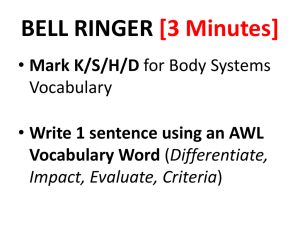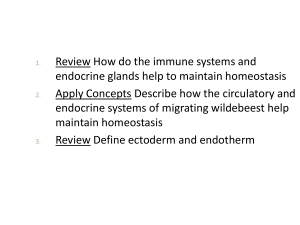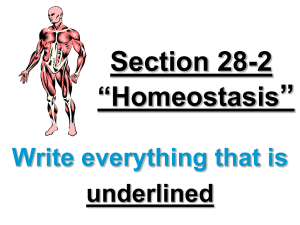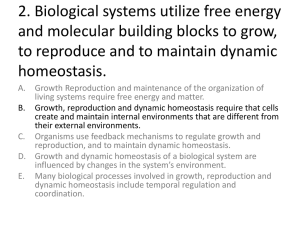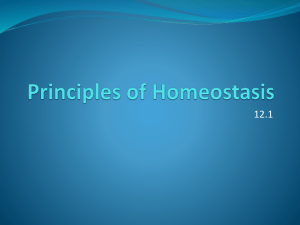The Human Organism
advertisement
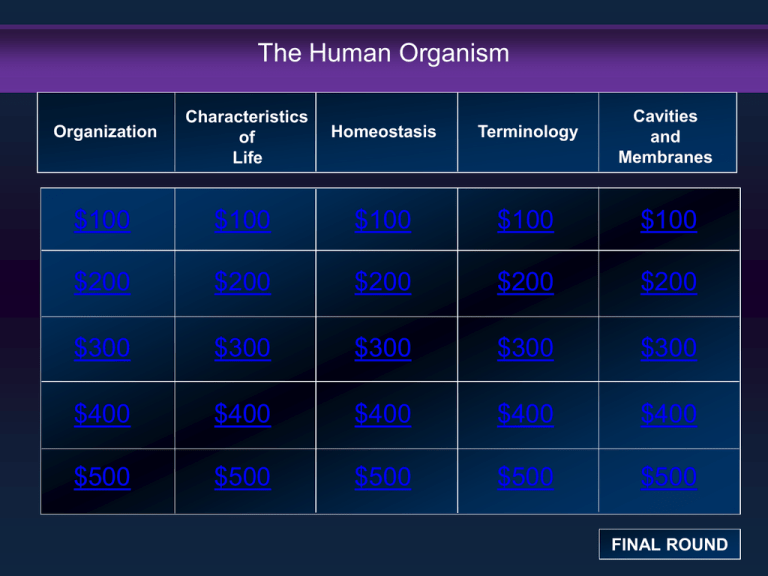
The Human Organism Organization Characteristics of Life Homeostasis Terminology Cavities and Membranes $100 $100 $100 $100 $100 $200 $200 $200 $200 $200 $300 $300 $300 $300 $300 $400 $400 $400 $400 $400 $500 $500 $500 $500 $500 FINAL ROUND Organization: $100 Question This level of organization consists of groups of similar looking cells with its surrounding material working together to perform a function: a. chemical b. cellular c. tissue d. organ ANSWER BACK TO GAME Organization: $100 Answer This level of organization consists of groups of similar looking cells with its surrounding material working together to perform a function: a. chemical b. cellular c. tissue d. organ BACK TO GAME Organization: $200 Question This is the smallest unit of an organism that carries out the basic function of life: a. molecule b. organelle c. cell d. organ ANSWER BACK TO GAME Organization: $200 Answer This is the smallest unit of an organism that carries out the basic function of life: a. molecule b. organelle c. cell d. organ BACK TO GAME Organization: $300 Question This organ system removes waste products from the blood, regulates pH and water balance: a. endocrine b. lymphatic c. integumentary d. urinary ANSWER BACK TO GAME Organization: $300 Answer This organ system removes waste products from the blood, regulates pH and water balance: a. endocrine b. lymphatic c. integumentary d. urinary BACK TO GAME Organization: $400 Question This organ system transports nutrients, waste products, gases and hormones throughout the body and regulates body temperature: a. lymphatic b. cardiovascular c. respiratory d. endocrine ANSWER BACK TO GAME Organization: $400 Answer This organ system transports nutrients, waste products, gases and hormones throughout the body and regulates body temperature: a. lymphatic b. cardiovascular c. respiratory d. endocrine BACK TO GAME Organization: $500 Question The muscular system functions to do this: a. produces movement b. maintains posture c. produces body heat d. all of these e. a and b only ANSWER BACK TO GAME Organization: $500 Answer The muscular system functions to do this: a. produces movement b. maintains posture c. produces body heat d. all of these e. a and b only BACK TO GAME Characteristics of Life: $100 Question Essential characteristics of life do not include: a. organization b. respiration c. reproduction d. metabolism ANSWER BACK TO GAME Characteristics of Life: $100 Answer Essential characteristics of life do not include: a. organization b. respiration c. reproduction d. metabolism BACK TO GAME Characteristics of Life: $200 Question Responsiveness is the ability of an organism to sense a change in its environment and react to it. True/False ANSWER BACK TO GAME Characteristics of Life: $200 Answer Responsiveness is the ability of an organism to sense a change in its environment and react to it. True/False BACK TO GAME Characteristics of Life: $300 Question This characteristic of life involves the passing down of genetic information by the formation of new cells or new organisms: a. growth b. development c. organization d. reproduction ANSWER BACK TO GAME Characteristics of Life: $300 Answer This characteristic of life involves the passing down of genetic information by the formation of new cells or new organisms: a. growth b. development c. organization d. reproduction BACK TO GAME Characteristics of Life: $400 Question This process involves unspecialized cells changing into cells with a specialized function: a. differentiation b. growth c. development d. reproduction ANSWER BACK TO GAME Characteristics of Life: $400 Answer This process involves unspecialized cells changing into cells with a specialized function: a. differentiation b. growth c. development d. reproduction BACK TO GAME Characteristics of Life: $500 Question The body’s ability to produce energy for muscle contraction during exercise by the break down of glycogen into glucose is this: a. growth b. metabolism c. morphogenesis d. development ANSWER BACK TO GAME Characteristics of Life: $500 Answer The body’s ability to produce energy for muscle contraction during exercise by the break down of glycogen into glucose is this: a. growth b. metabolism c. morphogenesis d. development BACK TO GAME Homeostasis: $100 Question The body’s ability to maintain itself in a steady state is known as this: a. negative feedback b. positive feedback c. variable d. homeostasis ANSWER BACK TO GAME Homeostasis: $100 Answer The body’s ability to maintain itself in a steady state is known as this: a. negative feedback b. positive feedback c. variable d. homeostasis BACK TO GAME Homeostasis: $200 Question This component of a feedback loop senses changes in the body: a. receptor b. control (integration) center c. effector d. none of these ANSWER BACK TO GAME Homeostasis: $200 Answer This component of a feedback loop senses changes in the body: a. receptor b. control (integration) center c. effector d. none of these BACK TO GAME Homeostasis: $300 Question This is an example of positive feedback: a. body temperature fluctuates between 99.1 and 98.0 b. pH levels of urine vary from 5.2 to 7.8 throughout the day c. Giving birth d. none of these ANSWER BACK TO GAME Homeostasis: $300 Answer This is an example of positive feedback: a. body temperature fluctuates between 99.1 and 98.0 b. pH levels of urine vary from 5.2 to 7.8 throughout the day c. Giving birth d. none of these BACK TO GAME Homeostasis: $400 Question Positive feedback creates a self-amplifying change of events that leads away from the body’s normal ranges. True/False ANSWER BACK TO GAME Homeostasis: $400 Answer Positive feedback creates a self-amplifying change of events that leads away from the body’s normal ranges. True/False BACK TO GAME Homeostasis: $500 Question This statement about negative feedback is true: a. maintains homeostasis b. deviation from the set point is resisted c. keeps parameters in the normal range d. all of these are true ANSWER BACK TO GAME Homeostasis: $500 Answer This statement about negative feedback is true: a. maintains homeostasis b. deviation from the set point is resisted c. keeps parameters in the normal range d. all of these are true BACK TO GAME Terminology: $100 Question This directional term describes the position of the antebrachium compared to the brachium: a. proximal b. distal c. superficial d. inferior ANSWER BACK TO GAME Terminology: $100 Answer This directional term describes the position of the antebrachium compared to the brachium: a. proximal b. distal c. superficial d. inferior BACK TO GAME Terminology: $200 Question When cutting the small intestine, this kind of section would produce an oval shaped piece: a. cross (transverse) b. frontal c. oblique d. midsagittal ANSWER BACK TO GAME Terminology: $200 Answer When cutting the small intestine, this kind of section would produce an oval shaped piece: a. cross (transverse) b. frontal c. oblique d. midsagittal BACK TO GAME Terminology: $300 Question This anatomical term refers to the point of the elbow: a. antecubital b. antebrachial c. palmar d. olecranon ANSWER BACK TO GAME Terminology: $300 Answer This anatomical term refers to the point of the elbow: a. antecubital b. antebrachial c. palmar d. olecranon BACK TO GAME Terminology: $400 Question The pedal region refers to this body part: a. foot b. ankle c. heel d. leg ANSWER BACK TO GAME Terminology: $400 Answer The pedal region refers to this body part: a. foot b. ankle c. heel d. leg BACK TO GAME Terminology: $500 Question The appendix is found in this abdominopelvic quadrant: a. RUQ b. RLQ c. LUQ d. LLQ ANSWER BACK TO GAME Terminology: $500 Answer The appendix is found in this abdominopelvic quadrant: a. RUQ b. RLQ c. LUQ d. LLQ BACK TO GAME Cavities and Membranes: $100 Question This body cavity contains the lungs: a. pleural b. thoracic c. pericardial d. dorsal ANSWER BACK TO GAME Cavities and Membranes : $100 Answer This body cavity contains the lungs: a. pleural b. thoracic c. pericardial d. dorsal BACK TO GAME Cavities and Membranes : $200 Question This structure separates the ventral body cavity into the thoracic and abdominopelvic cavities: a. pelvic brim b. mediastinum c. diaphragm d. lungs ANSWER BACK TO GAME Cavities and Membranes : $200 Answer This structure separates the ventral body cavity into the thoracic and abdominopelvic cavities: a. pelvic brim b. mediastinum c. diaphragm d. lungs BACK TO GAME Cavities and Membranes : $300 Question This organ is not retroperitoneal: a. kidneys b. adrenal glands c. spleen d. duodenum ANSWER BACK TO GAME Cavities and Membranes : $300 Answer This organ is not retroperitoneal: a. kidneys b. adrenal glands c. spleen d. duodenum BACK TO GAME Cavities and Membranes : $400 Question This serous membrane covers the surface of the heart: a. visceral pleura b. visceral pericardium c. parietal pericardium d. visceral peritoneum ANSWER BACK TO GAME Cavities and Membranes : $400 Answer This serous membrane covers the surface of the heart: a. visceral pleura b. visceral pericardium c. parietal pericardium d. visceral peritoneum BACK TO GAME Cavities and Membranes : $500 Question The parietal peritoneum covers: a. the anterior surface of the kidneys b. the abdominal wall c. the inferior surface of the diaphragm d. all of these e. b and c only ANSWER BACK TO GAME Cavities and Membranes : $500 Answer The parietal peritoneum covers: a. the anterior surface of the kidneys b. the abdominal wall c. the inferior surface of the diaphragm d. all of these e. b and c only BACK TO GAME FINAL ROUND Question When a boy is standing on his head, his chin is _______ to his mouth. a. superior b. inferior c. proximal d. distal ANSWER BACK TO GAME FINAL ROUND Answer When a boy is standing on his head, his chin is _______ to his mouth. a. superior b. inferior c. proximal d. distal BACK TO GAME


